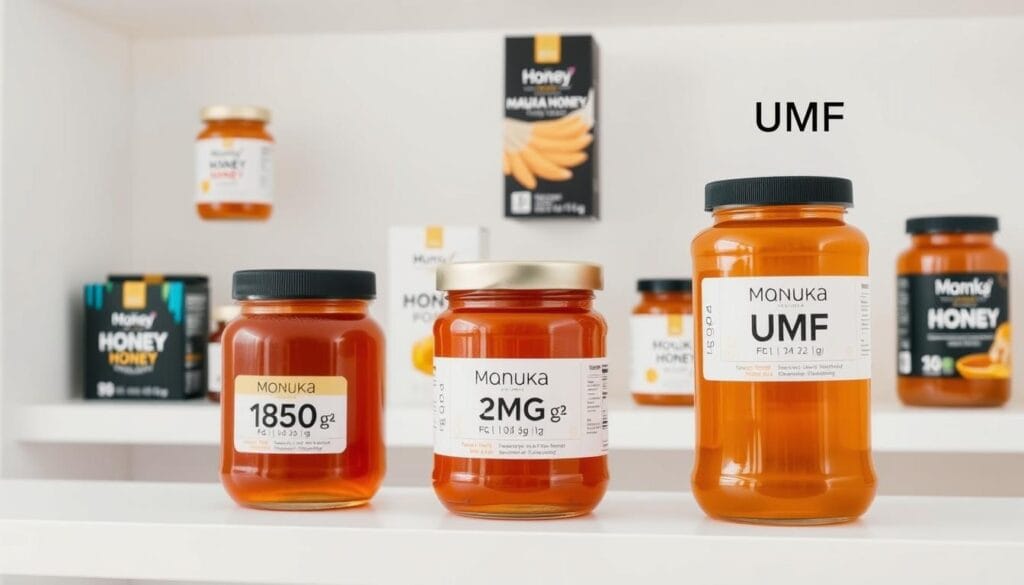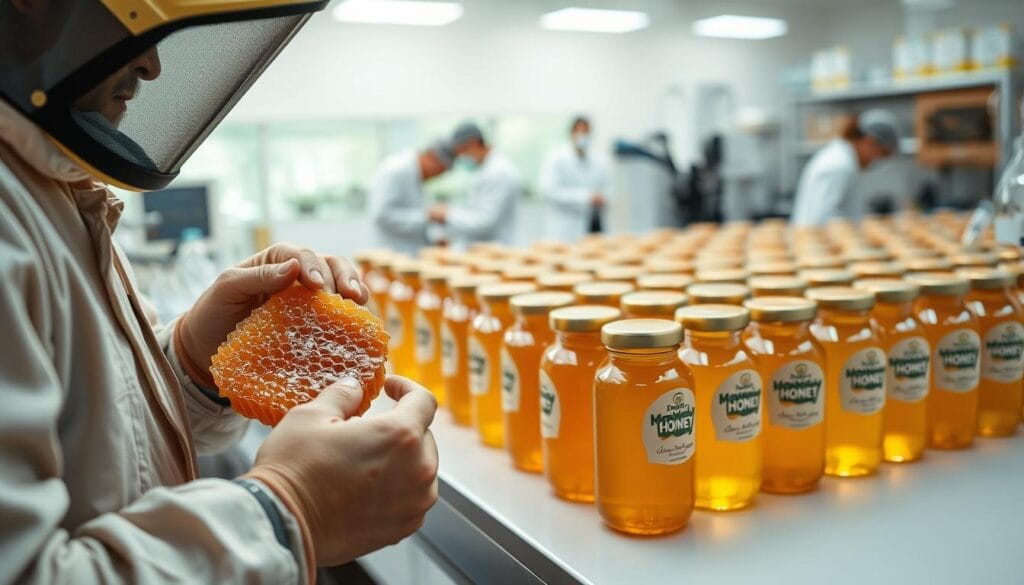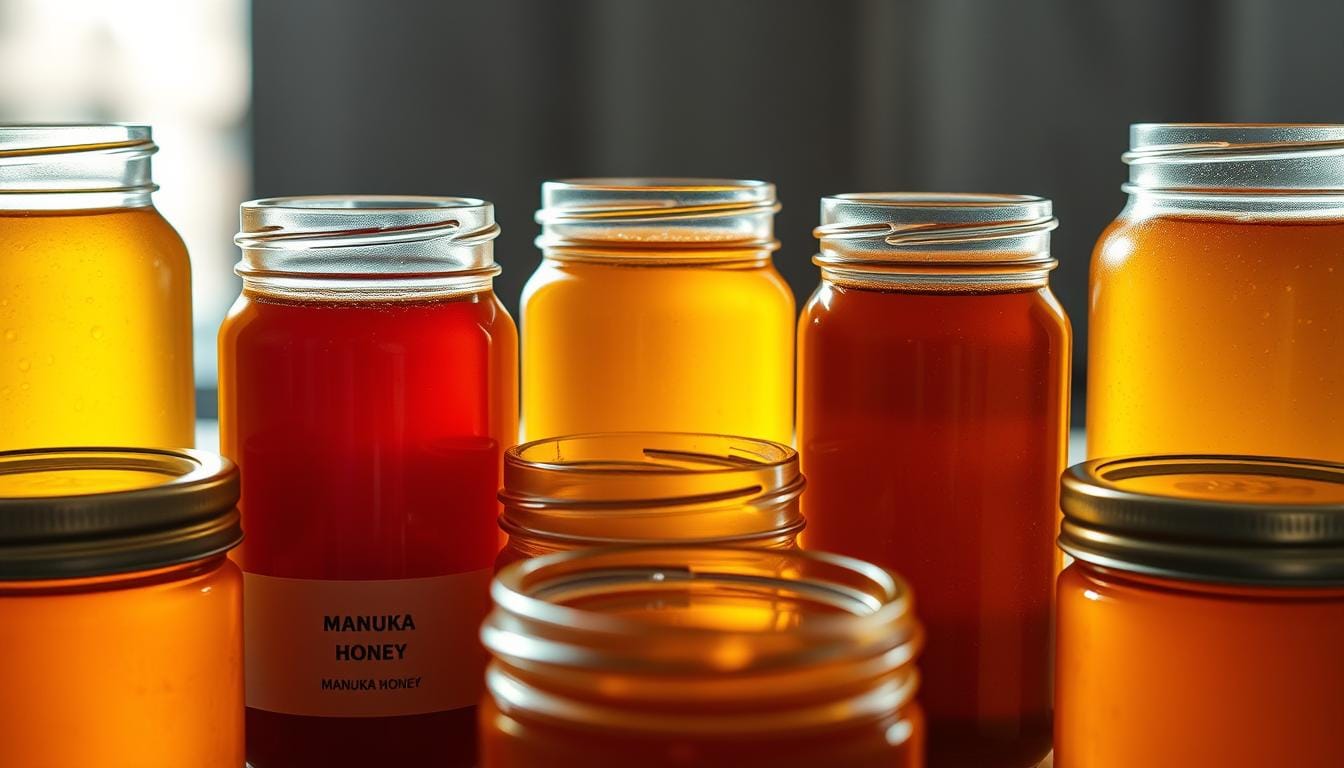Imagine finding a natural wellness secret in a golden jar of honey. This isn’t just any honey—it’s Manuka honey. It’s a powerful natural remedy that health enthusiasts worldwide love. What makes it special? It’s the unique compound called methylglyoxal, or MGO.
When you first hear about what is MGO in Manuka honey, you might wonder about its significance. Methylglyoxal levels are the secret behind this honey’s healing powers. Unlike regular honey, Manuka honey has more of this compound. This gives it extraordinary health benefits.
Scientists found that the higher the MGO rating, the more potent the honey. Manuka honey with high methylglyoxal levels can heal wounds and support digestive health. It offers a natural way to wellness that has caught the attention of researchers and health professionals.
Key Takeaways
- MGO stands for methylglyoxal, a unique compound in Manuka honey
- Higher MGO levels indicate stronger antibacterial properties
- Manuka honey’s potency is directly linked to its MGO concentration
- MGO provides natural healing and protective benefits
- Authentic Manuka honey is sourced from specific regions in Australia and New Zealand
Understanding the Basics of Manuka Honey
Explore the amazing world of active Manuka honey, a special natural gift from New Zealand. This honey is different from regular honey, with qualities that make it a health wonder.
Manuka honey is made from the nectar of the Leptospermun scoparium tree, found in New Zealand and Australia. What makes real Manuka honey special is its unique makeup and strong natural compounds.
Origins and Natural Formation
The making of Manuka honey is a cool process. Honeybees pollinate the Manuka bush, collecting nectar with special phytochemical markers. These markers give the honey its unique qualities.
- Produced exclusively in New Zealand and Australia
- Derived from Leptospermum scoparium tree nectar
- Requires specific environmental conditions for production
Difference Between Regular and Manuka Honey
Active Manuka honey is different from regular honey. It has special compounds that boost its health benefits. The main difference is methylglyoxal (MGO), which has strong antibacterial powers.
The Science Behind Active Compounds
Real Manuka honey is tested to check its chemical makeup. The MGO level shows how good and strong the honey is.
“Manuka honey represents a breakthrough in natural wellness, combining traditional healing with scientific validation.” – New Zealand Honey Research Center
| MGO Rating | Characteristics |
|---|---|
| 30-70 | Ideal for daily use |
| 100-240 | Enhanced therapeutic potential |
| 340+ | Maximum strength |
Learning about Manuka honey’s basics shows its unique nature and health benefits.
What Is MGO in Manuka Honey
Methylglyoxal (MGO) is the key to Manuka honey’s healing power. It makes Manuka honey different from regular honey. This unique compound is why Manuka honey is a top choice for natural health.
MGO levels in Manuka honey are measured in milligrams per kilogram. This shows how strong the honey is. Here’s what each level means:
- MGO 40+: Minimum antibacterial activity
- MGO 100-300: Ideal for general health maintenance
- MGO 500+: Recommended for more serious conditions
- MGO 850+: High-intensity antibacterial properties
- MGO 2000+: Maximum antibacterial potency available
The power of MGO is its strong antibacterial action. Unlike regular honey, Manuka honey uses methylglyoxal for its defense. Studies show MGO can stop harmful bacteria, even MRSA.
When picking Manuka honey, look at the MGO rating. The higher the rating, the stronger the honey’s health benefits. For daily health, choose honey with a rating of 100-300 mg/kg. For serious health issues, go for higher MGO levels.
Manuka honey’s MGO is nature’s powerful antibacterial solution, offering healing beyond traditional honey varieties.
The Relationship Between MGO and Antibacterial Properties
Manuka honey is known for its strong antibacterial properties. This is thanks to a compound called methylglyoxal (MGO). MGO is what makes manuka honey so good for your health.
Learning about MGO helps us see why manuka honey is so special. This compound forms in a unique way. It’s what makes manuka honey different from other honeys.
How MGO Forms in Manuka Honey
MGO comes from dihydroxyacetone (DHA) in the mānuka bush’s nectar. As the honey ages, DHA turns into MGO. This change gives the honey its strong antibacterial powers. The amount of MGO in the honey affects how well it works.
Scientific Evidence of Antibacterial Activity
Studies have shown that manuka honey is very good at fighting bacteria. It works against many types of harmful germs, including:
- Antibiotic-resistant bacteria
- Staphylococcus aureus
- Escherichia coli
- Candida species
MGO Concentration Levels Explained
The strength of manuka honey is measured by its MGO level. Higher MGO means stronger benefits. The Unique Manuka Factor (UMF) rating helps us understand this:
| UMF Rating | MGO Content | Antibacterial Strength |
|---|---|---|
| UMF 10+ | MGO 250+ | Moderate |
| UMF 15+ | MGO 550+ | Strong |
| UMF 20+ | MGO 850+ | Very Strong |
When picking manuka honey, choose the one with higher MGO levels. This ensures you get the most antibacterial benefits. The right amount can help wounds heal faster, boost your immune system, and protect you from harmful germs.
MGO vs UMF Grading Systems

When you look at manuka honey, you’ll see two main grading systems: MGO and UMF. Knowing about these systems helps you pick the best active manuka honey for you.
The UMF (Unique Manuka Factor) system started in 1998. It checks many things to see if manuka honey is good quality. It looks at more than just MGO, like:
- Leptosperin
- Methylglyoxal (MGO)
- Dihydroxyacetone (DHA)
- Hydroxymethylfurfural (HMF)
MGO grading, on the other hand, only looks at methylglyoxal levels. It gives a simple number from double digits to 2000. Most honeys are between MGO 83+ and MGO 1450+.
| UMF Grade | MGO Level | Classification |
|---|---|---|
| UMF 5 | MGO 83 | Table Grade |
| UMF 10 | MGO 263 | Therapeutic Grade |
| UMF 15 | MGO 514 | Antibacterial Grade |
| UMF 20 | MGO 829 | Superior Antibacterial Grade |
If you want the real deal manuka honey, check for UMF certification on the label. It means the honey has been checked for quality and where it comes from.
Health Benefits of High-MGO Manuka Honey
Manuka honey is more than just a sweetener. It’s packed with natural healing powers. High-MGO Manuka honey brings amazing health benefits, making it a great addition to your wellness routine.
Explore the amazing manuka honey benefits that can change your health:
Wound Healing Properties
High-MGO Manuka honey helps wounds heal faster. Dermatologist Dr. Rachel Nazarian says it’s scientifically proven to speed up healing. Its antibacterial properties can:
- Promote faster wound recovery
- Reduce infection risks
- Support skin regeneration
- Minimize scarring
Digestive Health Support
Manuka honey is great for your digestive system. Studies show it can fight harmful bacteria like H. pylori. It supports your overall digestive health.
| Digestive Health Benefits | Impact |
|---|---|
| Gut Bacteria Balance | Promotes beneficial bacteria growth |
| Gastrointestinal Protection | Reduces inflammation and bacterial infections |
| Recommended Daily Intake | 1-3 teaspoons per day |
Immune System Enhancement
Boost your immune system with high-MGO Manuka honey. Its strong antibacterial properties protect you, especially during flu season. It supports your body’s natural defenses.
Not all Manuka honey is the same. Look for a Unique Manuka Factor (UMF) of 15 or higher, or an MGO rating of at least 250. This ensures you get the most health benefits.
How to Choose the Right MGO Level
Choosing the right methylglyoxal levels in Manuka honey depends on your health goals and how you plan to use it. Knowing how Manuka honey is graded helps you pick the best one for your wellness needs.
Different MGO ratings have unique benefits for various uses:
- MGO 40+: Great for daily wellness and adding a gentle taste
- MGO 100+: Offers balanced antibacterial properties, good for general health
- MGO 300+: Provides strong immune support, perfect for cold and flu season
- MGO 525+: Has potent therapeutic potential for targeted health management
- MGO 850+: The highest grade for advanced medical uses
When picking your Manuka honey, think about these important factors:
- Your health goals
- How much you want to spend
- How you plan to use it (as a food or for health)
- Your current health condition
Make sure to check the UMF certification to confirm its authenticity. Also, verify the methylglyoxal levels on the label. Higher MGO ratings mean more antibacterial and therapeutic power. But, they also cost more.
Pro tip: Start with a moderate MGO level and gradually increase based on your body’s response and health professional recommendations.
Storage and Usage Guidelines for MGO Honey
Keeping active manuka honey fresh is key. Knowing how to store and use it helps you enjoy its health perks. It also keeps its special healing powers intact.
Storing manuka honey right is vital. Store it in a cool, dark spot. The ideal temperature is between 20°C to 25°C. Stay away from sunlight and extreme temperatures to keep its good stuff in.
Storage Best Practices
- Store in an airtight container
- Keep away from direct heat sources
- Use clean, dry utensils when handling
- Maintain room temperature storage
Recommended Daily Intake
For the best health benefits, take 1-2 teaspoons of Manuka honey each day. If you need more, adjust your intake based on your health goals and MGO level.
Application Methods
Manuka honey is great for more than just eating. You can use it on wounds, in skincare, or in your diet. Here are some ways to enjoy it:
- Direct consumption
- Mixing with tea
- Spreading on toast
- Adding to smoothies
Pro tip: To keep its benefits, don’t heat Manuka honey above 45°C.
Follow these tips to keep your Manuka honey good for 2 to 3 years after opening.
Authenticity and Quality Certification

Looking for real manuka sources means you need to know about quality certifications. It’s important to understand what makes Manuka honey genuine and effective.
Grading Manuka honey involves several steps to ensure it’s real. Sadly, up to 76% of honey in American stores might be fake.
- UMF (Unique Manuka Factor) Certification
- Ranges from 5+ to 35+
- Higher ratings mean stronger antibacterial power
- Shows honey’s purity and where it comes from
- MGO (Methylglyoxal) Rating System
- Measures antibacterial strength
- Ranges from 512 to 1835
- Shows how good the honey is
To check if Manuka honey is real, look for independent lab tests. Also, check for certificates of analysis and quality markers. Real Manuka honey has documents proving it’s from Leptospermum species.
When buying, look for certifications from trusted groups like:
- Australian Organic Certification
- Non-GMO Project Verified
- HACCP Food Safety Certification
Pro tip: Always ask for a detailed Certificate of Analysis to check the honey’s realness and MGO level.
MGO Stability and Shelf Life
It’s important to know how stable methylglyoxal levels are in active manuka honey. This is because the honey’s strength can change over time. Several factors can affect this.
How you store the honey is key to keeping its methylglyoxal levels high. Heat, sunlight, and extreme temperatures can harm its antibacterial properties. To keep your honey fresh, follow these storage tips:
- Store in a cool, dark place
- Keep the container tightly sealed
- Avoid temperature fluctuations
- Maintain original packaging
Manuka honey’s natural makeup helps it stay stable. Studies show that methylglyoxal levels stay consistent with the right storage.
| Storage Condition | MGO Level Preservation | Recommended Duration |
|---|---|---|
| Room Temperature | Up to 85% retention | 18-24 months |
| Refrigerated | Up to 92% retention | 24-36 months |
| Direct Sunlight | Less than 50% retention | Not recommended |
When buying manuka honey, check the expiration date. Also, look for products with clear MGO ratings. Higher MGO levels mean more stable and potent honey.
Comparing MGO Levels in Different Manuka Honey Brands
Exploring manuka honey grades shows big differences between brands. Knowing these helps you pick the best for your health.
Manuka honey MGO levels vary from MGO 83+ to MGO 1450+. This gives you many choices based on:
- Harvesting location in New Zealand
- Bee foraging patterns
- Processing techniques
- Extraction methods
Good brands are open about their MGO levels. The Unique Manuka Factor (UMF) certification also checks quality. This means you get real, top-notch manuka honey.
| MGO Range | Potency Level | Recommended Use |
|---|---|---|
| MGO 83-250 | Low | Daily wellness |
| MGO 250-500 | Medium | Immune support |
| MGO 500+ | High | Therapeutic applications |
When choosing manuka honey, choose brands with detailed lab tests and clear MGO labels. This ensures you get a real, quality product with health benefits.
Conclusion
Exploring what is MGO in manuka honey opens a world of natural health benefits. You’ve learned about methylglyoxal (MGO), showing how special this honey is. It boosts your immune system and fights bacteria, unlike regular honey.
The benefits of manuka honey go beyond just being sweet. With MGO ratings from 40+ to 850+, you can pick the right honey for you. It helps with daily health or specific needs, thanks to the MGO rating.
Studies keep showing how amazing manuka honey is. It stops bad bacteria, helps your stomach, and makes your skin better. Knowing about MGO helps you choose the best honey for your health.
Manuka honey is a standout natural resource as research grows. With your new MGO knowledge, you can find top-quality honey for real health gains. Start using manuka honey to improve your health naturally.
FAQ
What exactly is MGO in Manuka honey?
How do MGO levels affect Manuka honey’s quality?
How is MGO measured in Manuka honey?
What are the primary health benefits of high-MGO Manuka honey?
How can I identify authentic Manuka honey?
What MGO level should I choose for different purposes?
How should I store Manuka honey to preserve its MGO properties?
Can Manuka honey with high MGO levels be used topically?
How long does Manuka honey with MGO remain stable?
Are there any side effects of consuming high-MGO Manuka honey?
Source Links
- The Ultimate Guide to MGO 2000+ Manuka Honey – https://www.gatherbymanuka.com/en-us/blogs/manuka-honey-blog/manuka-honey-mgo-2000-plus?srsltid=AfmBOooZjiKCcrNNEkQOI5oefkJrNxSXFCNcDDtiyb_TNINMeA1hslaf
- UMF™ vs MGO vs KFactor vs BioActive vs MGS vs NPA? What Do These Manuka Honey Numbers Mean? – https://newzealandhoneyco.com/blogs/honey-articles/umf-vs-mgo-vs-kfactor-vs-bioactive-vs-mgs-vs-npa?srsltid=AfmBOor9gnUjCwAC3ja9fDSMt3lqWZFYo0NSjdESxMlHldn9fj0hdPD-
- What is MGO in Manuka Honey: Ratings & the New Zealand Government’s Science Definition – https://www.manukadoctor.co.uk/blogs/manuka-honey/what-is-mgo-in-manuka-honey
- Manuka Honey Grading Systems – UMF, MGO and more – https://wonderhoney.com/pages/manuka-honey-grading-systems?srsltid=AfmBOoriSgvSGVyG2OtQ_eoQiGlGKUYSJwXCPZi4rfRhKp6qevAGkoGZ
- Health Benefits of Manuka Honey – https://www.webmd.com/diet/health-benefits-manuka-honey
- What is MGO in Manuka Honey? – https://melora.co.uk/blogs/news/what-is-mgo-in-manuka-honey?srsltid=AfmBOoo1bf6JdAQj8Ua7quXfpOLXYhze_cVXolaFWOpEqtX8bR93usgQ
- The Ultimate Guide to MGO 2000+ Manuka Honey – https://www.gatherbymanuka.com/blogs/manuka-honey-blog/manuka-honey-mgo-2000-plus?srsltid=AfmBOopz8i-BauA91Xs7ri0w2g7tXUrFAXQbbtrlG2KJ_07zvGvwjGj4
- The Unique Benefits of Manuka Honey 100 MGO – NPA 5+ – https://www.manukalab.co.uk/blogs/news/the-unique-benefits-of-manuka-honey-100-mgo-umf-5?srsltid=AfmBOooeJM1E8HPvDhdP_l6fMb7C20jPqlScRb5b5ogcU5WOx_Rx3bLf
- What You Need to Know About MGO in Mānuka Honey – https://us.manukahealth.com/en/blogs/articles/mgo-explained-what-you-need-to-know-about-methylglyoxal-in-manuka-honey
- Studies on bioactivities of Manuka and regional varieties of honey for their potential use as natural antibiotic agents for infection control related to wound healing and in pharmaceutical formulations – https://pmc.ncbi.nlm.nih.gov/articles/PMC11194624/
- The comparison of the antioxidant, antibacterial and antiviral potential of Polish fir honeydew and Manuka honeys – Scientific Reports – https://www.nature.com/articles/s41598-024-82429-0
- The Difference Between MGO & UMF Mānuka Honey – https://aoteahealth.com/blogs/journal/the-difference-between-mgo-umf-manuka-honey
- UMF™ vs MGO vs KFactor vs BioActive vs MGS vs NPA? What Do These Manuka Honey Numbers Mean? – https://newzealandhoneyco.com/blogs/honey-articles/umf-vs-mgo-vs-kfactor-vs-bioactive-vs-mgs-vs-npa?srsltid=AfmBOoqedUCzzTWjlEEjBNUjTVLaYVxWaCi1cGoJsutWgOWCbDhabPIK
- Manuka Honey: Are Its ‘Healing Properties’ Legit Or A Waste Of Money? – https://www.huffpost.com/entry/health-benefits-of-manuka-honey_l_672bdc2fe4b01cfbdad3ac53
- The Ultimate Guide to MGO 2000+ Manuka Honey – https://www.gatherbymanuka.com/en-us/blogs/manuka-honey-blog/manuka-honey-mgo-2000-plus?srsltid=AfmBOorKK-0whTMXW8BoFpbMWwhjd7jlpEmXYfnYIS1ic94fE7WKe9sF
- The Unique Benefits of Manuka Honey 100 MGO – NPA 5+ – https://www.manukalab.co.uk/blogs/news/the-unique-benefits-of-manuka-honey-100-mgo-umf-5?srsltid=AfmBOop1PeNAQq0xSEI95suK4QcGjOUJoOc-wxXkDlLHhlo57h1CC2q4
- How to Choose the Best Mānuka Honey for Your Needs – https://melora.co.uk/blogs/news/how-to-choose-the-best-manuka-honey-for-your-needs?srsltid=AfmBOoq4Sdb8FyTKG0ln9P49BcsAalnb-xxOiIjTyOvtFtslKK4X9NJ3
- UMF™ vs MGO vs KFactor vs BioActive vs MGS vs NPA? What Do These Manuka Honey Numbers Mean? – https://newzealandhoneyco.com/blogs/honey-articles/umf-vs-mgo-vs-kfactor-vs-bioactive-vs-mgs-vs-npa?srsltid=AfmBOooMpkqT92LtVuN9tq7_Uyi1ffpny3WZHqY1CV2kS0L_o6juCp5l
- UMF vs MGO: Manuka Honey Grading Systems | The Ultimate Guide – https://manukasouth.com/pages/resources/manuka-honey-grading-systems?srsltid=AfmBOop-sRQpmizwGrlBRBeGq4VTWpDdf6IsSbZa6g3baKX6x1HSERzg
- The Ultimate Guide to MGO 2000+ Manuka Honey – https://www.gatherbymanuka.com/en-us/blogs/manuka-honey-blog/manuka-honey-mgo-2000-plus?srsltid=AfmBOopYFAQ2jcZtWZWJL6S1GKeZ34lRWjkmwQkZk89gRk1-3lMXpt0D
- Manuka Honey MGO 100+/5+ UMF – https://www.florahealth.com/products/manuka-honey-mgo-100-5-umf?srsltid=AfmBOop1I7lCvqlUlLHjOe1yHb-yaMEOwjCDNN_A03CSRwkDS2HdoVGT
- How To Store Manuka Honey To Ensure Maximum Freshness – https://natures-nutrition.co/blogs/news/how-to-store-manuka-honey-to-ensure-maximum-freshness
- Decoding Manuka honey ratings and certifications for quality and authenticity – https://biosota.com.au/blogs/resources/decoding-manuka-honey-ratings-and-certifications-for-quality-and-authenticity?srsltid=AfmBOooUMtn13Q-X5btQh0UyMqyCZocFD8N-5hjROI34jRYDS5yvhqGN
- Finding Authentic Manuka Honey: Your Complete Guide to Real Manuka Honey – https://manukasouth.com/pages/resources/authentic-manuka-honey?srsltid=AfmBOoq4hvKCU_lWeGPr8ODX-KWU23hhfoIS8WE6arRmyJZK0N5zW9JO
- Physicochemical parameters, microbiological quality, and antibacterial activity of honey from the Bucovina region of Romania – https://pmc.ncbi.nlm.nih.gov/articles/PMC11799142/
- Manuka honey as a non-antibiotic alternative against Staphylococcus spp. and their small colony variant (SCVs) phenotypes – https://pmc.ncbi.nlm.nih.gov/articles/PMC11168119/
- UMF™ vs MGO vs KFactor vs BioActive vs MGS vs NPA? What Do These Manuka Honey Numbers Mean? – https://newzealandhoneyco.com/blogs/honey-articles/umf-vs-mgo-vs-kfactor-vs-bioactive-vs-mgs-vs-npa?srsltid=AfmBOoqnUc9iRthK0kllB55SAXeBRyJlSsM6K1Vj7e0c96O_r6OtDUsp
- UMF vs MGO: Manuka Honey Grading Systems | The Ultimate Guide – https://manukasouth.com/pages/resources/manuka-honey-grading-systems?srsltid=AfmBOooetnMt3qm_OjP6N53lNYI54lsw0gH34P1mGZlIFbaq18FgKmNK
- What is MGO in Manuka Honey? – https://melora.co.uk/blogs/news/what-is-mgo-in-manuka-honey?srsltid=AfmBOoo5xKywdkKpdqru3LkNHGN6T5FedDC34nIKFG4s3K1eUYWdYBHm
- Unleash the Power of Manuka Honey 850 MGO – NPA 20+: A Healthier You Awaits – https://www.manukalab.co.uk/blogs/news/unleash-the-power-of-manuka-honey-850-mgo-umf-20-a-healthier-you-awaits?srsltid=AfmBOopBgil4P5kWLBNXZF-vyHZIvSPGldZBcyk1LpstG0jRdDqAZCYo
